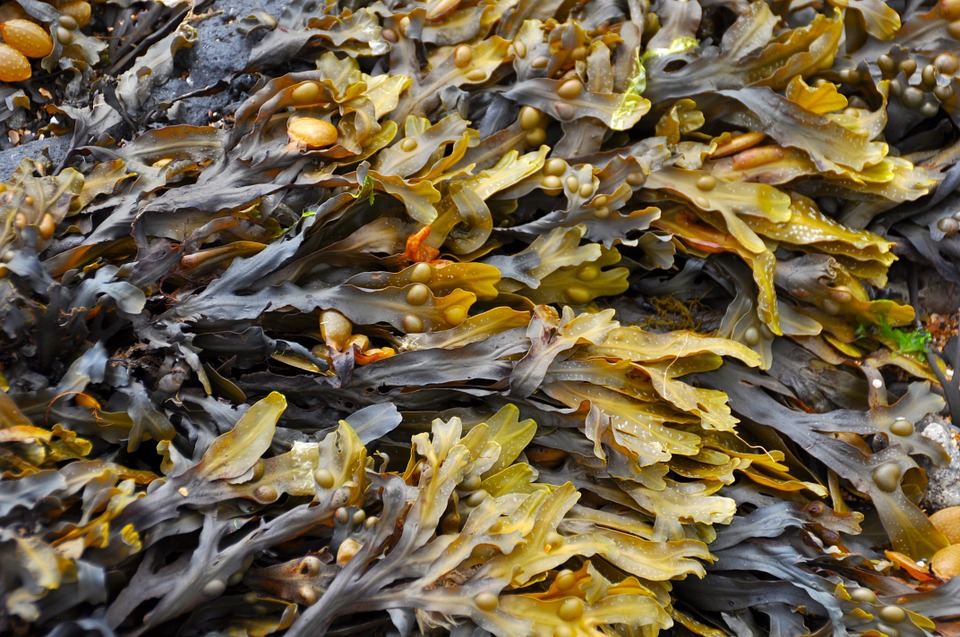In the search for sustainable materials for the clothing industry, algae seem to be an interesting alternative to cotton, for example, because they grow highly regeneratively in seawater, for example, and require virtually no water for processing. In addition, algae substances have a vitalising effect. We have taken a look at the special features and challenges.
Algae do not belong to the genus of plants, but are heterocont. They grow in lakes and seas, e.g. in kelp forests, and have done so for about 5 to 23 million years. Seaweed (a type of algae) can grow up to 100 metres long. Algae produce a large amount of oxygen and bind enormous amounts of carbon dioxide.
Seaweed can be harvested and will grow back in 2-4 years anywhere in the world. They are therefore a valuable resource. Algae are resilient but also biodegradable. These are good conditions for circular systems. Couldn’t we use algae as fabric for our clothes?
Some companies, such as Smartfiber AG from Germany, have come up with this idea. For 15 years they have been selling SeaCell, a yarn made from algae and modal (wood-based). In addition, the company GREY Berlin offers the patented Vitadylan fabric, which contains zinc as well as algae. Both companies mainly process Icelandic brown algae.
The special thing about the algae fabric is that it is soft and breathable. The natural moisture of the skin when it is worn releases minerals, trace elements and vitamins that have an anti-inflammatory effect on the skin, among other things. In summer they cool the skin and in winter they warm it particularly well. The substances are also able to bind perspiration odour. Algae activate cell regeneration and protect the skin from free radicals. A boon for the skin. This effect is already used in the cosmetics industry. The proportion of zinc dioxide in the fibres also protects the body from UVA/UVB radiation.
In contrast to conventional materials most commonly used in the clothing industry, SeaCell and Vitadylan do not contain any chemicals or other harmful substances. SeaCell has been awarded the OEKO-TEX® Standard 100, among many other certifications.
The fibres are made from renewable resources. These are completely untreated and organic. The Icelandic seaweed comes from seaweed fields. There they are harvested gently and sustainably. In the process, only the upper part of the algae is removed, which allows it to sprout again. The harvested algae are then coarsely chopped, ground and evenly incorporated into the cellulose fibre. The production process uses little energy and, above all, very little water. Algae can be used in many ways, e.g. in the cosmetics industry, as food, as colour pigments.
Besides the two companies already mentioned, algiKnit from Brooklyn, New York is working on algae-based bio polymer yarns. They want to use them primarily for knitting, due to its zero-waste approach. The first implementations will be accessories such as handbags.
Several designers are already experimenting with the algae fabric (e.g. Umasan or Seaweed Fashion). There are already clothes made of algae on the market. Here in Berlin, for example, there is GREY Berlin Fashion. They make basics like leggings, underwear and T-shirts from the miracle fabric. Other suppliers include CALIDA, Speidel, Palmers, Hugo Boss and FTC Cashmere. A very nice application is the baby nappy SUMO. At Story of mine you can get homewear made from algae.
In addition, Vivobarefoot from England produces a natural foam made from algae, which is used for the production of bath slippers, among other things. Vivobarefoot harvests the algae where they grow but would cause damage. Bathing slippers made from seaweed could already be bought at H&M.
The so-called sea-cell fibres are still very cost-intensive and not yet really established. There are extreme challenges for spinners and weavers whose machines do not provide perfect environments for processing the material. However, the examples on the market show that it is possible. Especially for allergy sufferers and people with sensitive skin, this is a blessing. We hope that more companies will work with algae-based materials.
techround.co.uk/startups/sustainable-textile-startups
www.forbes.com/sites/jenniferhicks/2018/06/15/see-how-algae-could-change-our-world
www.lilligreen.de/gruene-mode-aus-algen
www.fashion-insider.de/2695/kleidung-aus-algenfasern-neuer-trend
www.deutschlandfunkkultur.de/mode-aus-algen-die-umweltfreundliche-alternative-aus-dem.1008.de.html?dram:article_id=385287
greyberlin.de
www.fashion-insider.de/2695/kleidung-aus-algenfasern-neuer-trend
utopia.de/ratgeber/kleidung-der-zukunft-algen-milch-nesseln-plastik
presseinfos.at/powerstoff-alge-grey-fashion-mit-natuerlichen-meeresmineralien
www.greengadgets.de/2020/07/30/biobombola-algen-zuechten-und-spass-dabei
www.story-of-mine.com


